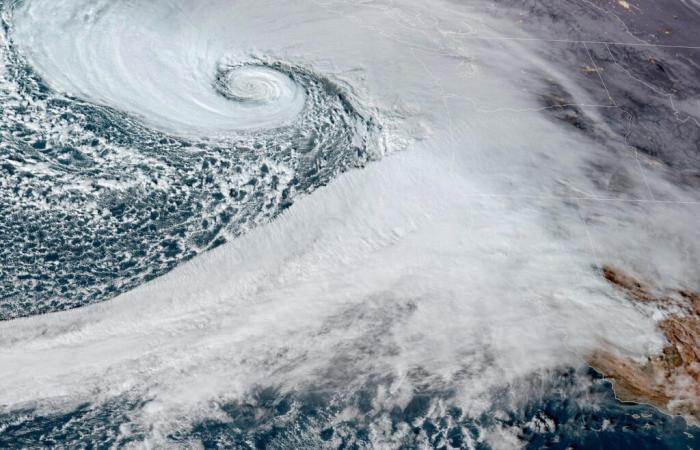A “bomb cyclone” forms off the coast of western Canada and the U.S. in a composite satellite image November 19, 2024.CIRA/NOAA/Reuters
Hurricane-force winds of up to 159 km/h have slammed into parts of the British Columbia Coast as a massive storm swirling off Vancouver Island severed highways and cut power to about 225,000 people.
Winds from the bomb cyclone weather system were expected to reach 120 km/h on the central and north coast, although remote Sartine Island, off the northern tip of Vancouver Island, was battered by the most powerful gusts, equivalent to a Category 2 hurricane.
Winds exceeding 100 km/h were recorded in multiple areas late Tuesday, with gusts approaching 80 km/h at Vancouver’s airport.
BC Hydro says most of the blacked-out customers were on Vancouver Island, but there were also dozens of outages across Metro Vancouver and the Sunshine Coast.
The Transportation Ministry says multiple highways on Vancouver Island have been closed because of downed power lines, fallen trees and debris, with more closures expected as the storm moves through.
A bomb cyclone is caused by rapidly dropping atmospheric pressure at the centre of a weather system.
Environment Canada says the storm is parked about 400 kilometres west of Vancouver Island and will remain offshore, with the winds hitting B.C.’s coastal areas not expected to weaken until later today.
BC Ferries cancelled numerous sailings Tuesday between Vancouver Island and the Lower Mainland, and warned that trips could be affected through today.
The storm swept across the northwest U.S. Tuesday evening, battering the region with strong winds and rain and causing widespread power outages and downed trees that killed at least one person.
The Weather Prediction Center issued excessive rainfall risks through Friday and hurricane-force wind warnings were in effect as the strongest atmospheric river — a large plume of moisture — that California and the Pacific Northwest has seen this season overwhelms the region.
Downed trees struck homes and littered roads across northwest Washington. In Lynnwood, Wash., a woman died Tuesday night when a large tree fell on a homeless encampment, South County Fire said in a statement on X.
In Seattle, a tree fell onto a vehicle, temporarily trapping a person inside, the Seattle Fire Department reported. The agency later said the individual was in stable condition.
“Trees are coming down all over the city & falling onto homes,” the fire department in Bellevue, about 10 miles (16 kilometers) east of Seattle, posted on the social platform X. “If you can, go to the lowest floor and stay away from windows. Do not go outside if you can avoid it.”
Early Wednesday, over 600,000 houses in Washington State were reported to be without power on poweroutage.us. But the number of outage reports fluctuated wildly throughout Tuesday evening likely due in part to several weather and utility agencies struggling to report information on the storm because of internet outages and other technical problems. It wasn’t clear if that figure was accurate. More than 15,000 had lost power in Oregon and nearly 19,000 in California.
In northern California, flood and high wind watches were in effect, with up to 8 inches (20 centimeters) of rain predicted for parts of the San Francisco Bay Area, North Coast and Sacramento Valley. Dangerous flash flooding, rock slides and debris flows were expected, according to the National Weather Service Weather Prediction Center.
A winter storm watch was issued for the northern Sierra Nevada above 3,500 feet (1,066 meters), where 15 inches (28 centimeters) of snow was possible over two days. Wind gusts could top 75 mph (120 kph) in mountain areas, forecasters said.
The National Weather Service issued a flood watch for parts of southwestern Oregon through Friday evening, while rough winds and seas halted a ferry route in northwestern Washington between Port Townsend and Coupeville.
A blizzard warning was issued for the majority of the Cascades in Washington, including Mount Rainier National Park, starting Tuesday afternoon, with up to a foot of snow and wind gusts up to 60 mph (97 kph), according to the weather service in Seattle. Travel across passes could be difficult if not impossible.
–With files from The Associated Press






